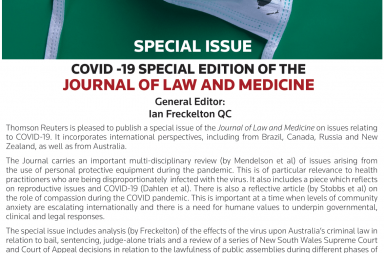The latest issue of The Tort Law Review (Volume 20 Part 2) contains the following material:
Articles
The neighbour principle in the 21st century: Yesterday’s revolution – Keith Stanton
This article considers whether Lord Atkin’s neighbour principle has any role to play in modern law. It considers modern duty of care methodology, the role of policy-based thinking, the emergence of “pockets†of negligence liability, incrementalist thinking and the impact of the European Convention on Human Rights on immunities in negligence.
To purchase this article, complete the Individual Article Sale order form and email it to [email protected].
The effect of acts of God and coincidences on the chain of causation: Comparative common law and civil law perspectives – Douglas Hodgson
Historically, intervening causation issues have not been systematically and definitively addressed in the legal literature. Such issues, as a subspecies of causation law, can be quite complex and difficult to judicially resolve, but they can and do commonly arise across a broad spectrum of human activity. Novus actus interveniens (the Latin maxim adopted by common law judges) has been pleaded from time to time over the past 150 years or so in cases involving so-called “acts of God†(or, according to taste, extraordinary natural phenomena or force majeure) and coincidental events. This article examines when, in each scenario, the chain of causation between the defendant’s negligence and the plaintiff’s injuries or loss will be held to have been broken by each of these intervening events and identifies the relevant legal tests. More specifically, what events qualify as acts of God and what is the main distinction between them and coincidences? The common law and civil law approaches to resolving intervening causation issues are compared and contrasted with a view to identifying the core principles and distinctions which inform judicial reasoning and decision-making in these contexts.
To purchase this article, complete the Individual Article Sale order form and email it to [email protected].
Unjustly ignored: Revitalising the doctrine of waiver of tort in contaminated land litigation – Brandon D Stewart
Waiver of tort has historically been used to vindicate property rights by forcing a defendant to disgorge ill-gotten gains acquired through wrongful interference with land. Drawing from this rich history, this article argues for the expanded use of the doctrine as either an independent cause of action or restitutionary remedy in contaminated land litigation in Canada. Liability would arise in situations where property is contaminated by dangerous or even innocuous chemicals that violate a landowner’s right to be the ultimate decision-maker with respect to the use and control of her or his land. Whether a landowner is entitled to a particular disgorgement remedy would depend on the wrongfulness of the defendant’s conduct. Within these parameters, waiver of tort is able to create a system of equitable liability that appropriately captures the economic and ecological losses arising from chemical contamination, and deters the irresponsible discharge and dumping of toxic chemicals.
To purchase this article, complete the Individual Article Sale order form and email it to [email protected].
What to do about useful nuisances? Antrim Truck Centre and its implications for toxic torts – Nathan J Benson
The Ontario Court of Appeal recently held that when an alleged nuisance arises from an essential public service, the public benefit from that service should be given special consideration, potentially negating liability for what would otherwise be a nuisance. The implications of this doctrinal development for nuisance law generally and toxic tort litigation in particular are assessed, focusing on two aspects of the court’s reasoning: the emphasis placed on balancing the competing interests of the parties, and the weight assigned to the utility of the defendant’s conduct. It is argued that the court’s position is a significant departure from previous jurisprudence, and should be rejected in favour of a continued focus on the defence of statutory authority as the primary means of distinguishing between public works and private enterprise in nuisance law. While a balancing of competing interests is inherent in the law of nuisance, this balancing must not become disconnected from the modern purpose of the tort, which is to protect against unreasonable interferences with the use of land, including those caused by harms to the environment. In line with this purpose, four doctrinal clarifications are recommended to promote consistency in determining what interferences are unreasonable, and therefore actionable.
To purchase this article, complete the Individual Article Sale order form and email it to [email protected].
For the pdf version of the table of contents, click here: Tort L Review Vol 20 Pt 2 Contents.


